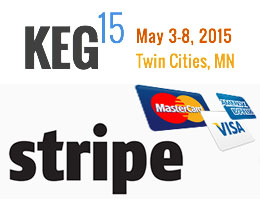What’s New at Kinetic: Building Smart in 2026
At Kinetic, we believe the future of Business Process Management isn’t bigger—it’s smarter.
by Kelly Heikkila

by Kelly Heikkila
Registration for Kinetic Data’s annual user conference, the Kinetic Enthusiasts Group (KEG), opened last week. This year we wanted to make the registration process as seamless as possible. Our outstanding hotel venue, The Depot Renaissance, offered a great landing page just for us booking the hotel for our event. We also wanted to accept credit cards right within the form, versus emailing out an invoice as we had done in the past. Enter Kinetic Request, Kinetic Task and Stripe credit card checkout service.
 Adding Stripe checkout into a form is a fairly quick three-step process:
Adding Stripe checkout into a form is a fairly quick three-step process:
Note that in this process you never store any credit card details. Stripe simply gives you a token in the javascript that represents the credit card information and that token is passed along on the back-end with other charge details to complete the loop. It’s both user-friendly and secure. And that’s it! You’re ready to start accepting credit card payments.
Solutions like this to what were once (not that long ago) very difficult problems are why I love web development today. Instead of worrying about how you’re going to securely store and charge someone’s credit card, you can focus on other aspects of your business that really add value to your customer. This is doubly true with Kinetic Request and Kinetic Task. Our platform was designed to plug in both cloud-based and internal services seamlessly with very little code. Organizations now have the power to create rich, consumer-like, intuitive experiences for both internal and external stakeholders.

At Kinetic, we believe the future of Business Process Management isn’t bigger—it’s smarter.

IT support automation uses software workflows, rule engines, AI/ML, and integrations to automate...

Business process reimagined is the strategic renewal of how work gets done by combining modern digital...